In my last post I wrote about the mystery of my cousin Celina Nusbaum, who had been married to Inglis Cameron, with whom she’d had a son Edward James. Then she became Sally Carnes, married to Donald Carnes, and her son Edward James also took on the surname Carnes. Celina’s granddaughter Tracy had commented on my blog and helped to fill in some details about Celina. But there was more to learn. Why did Celina change her name and move to Texas? Who was Donald Carnes, and what had happened to Inglis Cameron?
An old friend of the family had shared his memories with Tracy and her brother, and Tracy sent me the notes she had from that conversation. Since I cannot prove some of the details alleged in those notes, I need to be careful what I write here, but from that conversation, Tracy understood that her grandfather had gotten into some sort of trouble, had changed his name to Donald Carnes, and had moved the family to Texas to start over. Celina became Sally Carnes, and Edward James became E.J. Carnes. Tracy said that her mother’s maiden name had been Barnes, and she thought that the family combined Cameron with Barnes to create Carnes as their new name.
Why did they choose Texas as a place to move? On Donald Carnes’ death certificate, it says that Donald was born on December 2, 1884, in “Corsicane [sic], Texas.”
![Ancestry.com. Texas, Death Certificates, 1903–1982 [database on-line]. Provo, UT, USA: Ancestry.com Operations, Inc., 2013. Original data: Texas Department of State Health Services. Texas Death Certificates, 1903–1982. iArchives, Orem, Utah.](https://brotmanblog.com/wp-content/uploads/2015/11/donald-carnes-death-certificate.jpg?w=584&h=477)
Ancestry.com. Texas, Death Certificates, 1903–1982 [database on-line]. Provo, UT, USA: Ancestry.com Operations, Inc., 2013.
Original data: Texas Department of State Health Services. Texas Death Certificates, 1903–1982. iArchives, Orem, Utah.
![Charles Cameron death certificate Ancestry.com. Pennsylvania, Death Certificates, 1906-1963 [database on-line]. Provo, UT, USA: Ancestry.com Operations, Inc., 2014. Original data: Pennsylvania (State). Death certificates, 1906–1963. Series 11.90 (1,905 cartons). Records of the Pennsylvania Department of Health, Record Group 11. Pennsylvania Historical and Museum Commission, Harrisburg, Pennsylvania.](https://brotmanblog.com/wp-content/uploads/2015/11/charles-cameron-death-cert.jpg?w=584&h=575)
Charles Cameron death certificate
Ancestry.com. Pennsylvania, Death Certificates, 1906-1963 [database on-line]. Provo, UT, USA: Ancestry.com Operations, Inc., 2014.
Original data: Pennsylvania (State). Death certificates, 1906–1963. Series 11.90 (1,905 cartons). Records of the Pennsylvania Department of Health, Record Group 11. Pennsylvania Historical and Museum Commission, Harrisburg, Pennsylvania.
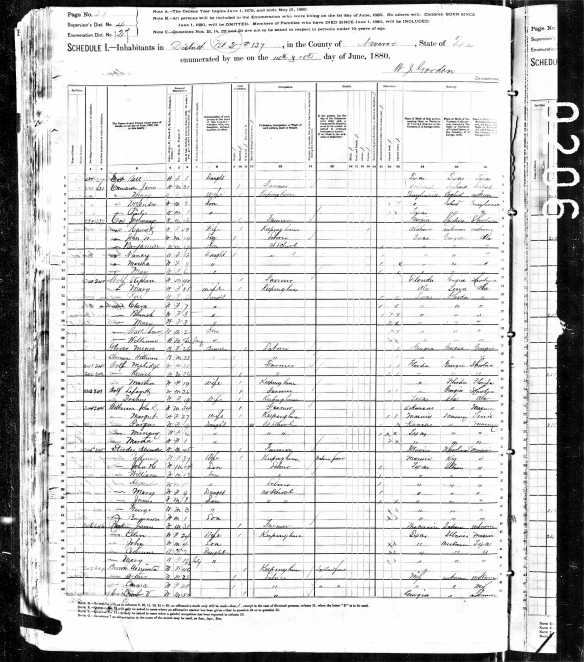
James Cameron and family 1880 census
Year: 1880; Census Place: Navarro, Texas; Roll: 1321; Family History Film: 1255321; Page: 314D; Enumeration District: 127
The Camerons later returned to Pennsylvania, where Inglis was born on December 2, 1883, according to his World War I draft registration and several census records.
So Inglis had family ties to Corsicana, Texas. It seems clear to me that Inglis Cameron became Donald Carnes and that he changed his birth place to Corsicana where his parents had once lived, perhaps to give himself credible Texas roots. He also kept his birthday (though not the year) the same. Although I have no official documentation to prove that he changed his name, the circumstantial evidence certainly points that way.
Donald Carnes’ application for a Social Security number seems to support this conclusion as well. There is an entry in the Social Security Applications and Claims Index on Ancestry.com that indicates that Donald Carnes filed for a Social Security number in October 1940. The SSACI index lists Donald Carnes’ birth place as Corsicana, Texas, and his birth date as December 6, 1884. It lists his parents’ names as James Carnes and Mary Smith. Inglis Cameron’s parents were James and Mary Cameron—coincidence? I think not. I have sent for the actual application, but I doubt it will say he was also once known as Inglis Cameron.
Thus, I am convinced that, as the family friend told Tracy, Inglis Cameron became Donald Carnes, that Celina Nusbaum Glessner Cameron became Sally Carnes, and that Edward James Cameron became Edward James Carnes. But why? What had happened to cause them to change their names and move to Texas?
I was able to find Inglis E.D. Cameron listed as a lawyer in the Philadelphia directory in 1922 and in 1923. In 1923, he was listed as part of a firm, Cameron & Carey. In 1925, he was listed in the NYC directory as an attorney, but in the Philadelphia directory, it only listed his residence. In the 1930 directory, he is not listed at all. (There are no online Philadelphia directories for the years between 1925 and 1930.)
I needed to find a source for news about Philadelphia during the 1920s and 1930s, but the databases to which I subscribe have no Philadelphia papers dated past 1922. The only online database that has Philadelphia newspapers dated after 1922 is a wonderful free website known as Fulton History or Old Fulton Postcards. It is run by one man who has scanned and uploaded millions of pages of old newspapers, including the Philadelphia Inquirer. It is not always an easy site to use because you have to be very persistent and creative in searching, and my first time through I had not found anything too helpful. But after receiving Tracy’s comment on the blog, I was motivated to spend more time learning how to search the Fulton site.
What did I learn? Inglis E.D. Cameron had been a member of a law firm in Philadelphia called Cameron & Carey, as indicated in the 1923 Philadelphia directory; his partner was James T. Carey. In 1922 they represented a company called United Auto Stores, a chain that sold auto parts and accessories. The company was founded by Edward B.P. Carrier, a young man who was the son of a doctor in Philadelphia and who had been a student at the University of Pennsylvania when he left to start the company. By 1922, the company had over fifty stores in many states, and Edward “Bud” Carrier was only 28.
In February, 1922, Carrier and others involved in the business of United Auto Stores were sued by stockholders for conspiracy to commit stock fraud; they were allegedly lying to purchasers about the value of the company in order to induce them to buy stock and also profiting by using a shell company as the selling agent of the stock.
The story was covered in detail by The Philadelphia Inquirer, and in some of the articles there are references either to Inglis Cameron, his partner James T. Carey, or their firm Cameron & Carey as the counsel to United Auto Stores. See, e.g., “Gigantic Swindle Seen in Collapse of Auto Stores Co.,” Philadelphia Inquirer, February 24, 1922, p. 1, 3 [names Cameron & Carey as counsel and quotes James T. Carey]; “File Court Actions to Save Creditors of Auto Stores Co.,” Philadelphia Inquirer, February 25, 1922, pp. 1, 9; “Gay Parties Marked Spending Orgy of Auto Stores Head,” Philadelphia Inquirer, February 26, 1922, p. 1; “Auto Stores Chief Denies All Charges of Wild Spending,” Philadelphia Inquirer, February 27, 1922, p. 1, 5 [mentions Cameron & Carey as company counsel and Inglis E.D. Cameron specifically as present during questions by reporter]; “Auto Stores Yields Up But $30,” Philadelphia Inquirer, February 28, 1922, p. 2; “Auto Stores Head Called Falsifier,” Philadelphia Inquirer, March 1, 1922, p. 2; “Receivers Named for Auto Stores,” Philadelphia Inquirer, March 2, 1922, p.2; “Hint of US Action Shock to Carrier,” Philadelphia Inquirer, March 4, 1922, p. 2.
By March 7, 1922, United Auto Stores was in permanent receivership, and soon thereafter its assets were sold to Gimbel Brothers. “Special Referee to Probe Crash of Carrier’s Concerns,” Philadelphia Inquirer, March 7, 1922, pp. 1. 13.
The timing of this case unfolding raised some red flags for me. It was in the spring of 1921 that “thieves” struck Inglis Cameron’s company, Cameo Dress Company, at least three times. And it was on February 22, 1922, that the newspaper reported that Cameo Dress Company had been damaged by fire. The first story about the United Auto Stores’ charges appeared in the paper on February 24, 1922, two days later. Could this be just coincidence? Or is there a connection?
In 1925, sixty-four individuals and the corporation itself were indicted on grounds of conspiracy to commit fraud. Carrier was indicted as well as other officers of the company and a number of individuals who had been involved in the sales of United Auto Stores stock. Absent, however, from the list of indicted individuals were the names of Inglis E.D. Cameron and James T. Carey.
And then the case disappeared from the papers. I don’t know what happened with the charges. Was there a trial? A verdict? It’s very odd, but so far I have not found answers to those questions. But even before the Auto Stores indictment, Samuel Safir and Samuel Rosenblatt, two of the first three names listed in the article identifying those who were indicted in the Auto Stores matter, had been charged in another case of stock fraud, this one involving the Altoona Glass Casket Company, a story that made the newspapers throughout the country. E.g., “Glass Casket Co. Promoters Jailed,” Boston Herald, February 2, 1924, p. 4. Safir and Rosenblatt were ultimately convicted in the casket case.
As for Edward B.P. Carrier, as far as I can tell he was not convicted of any charges. He married in 1924 and was living on Long Island, New York, in 1930 with his wife and family. He was working as a real estate broker. In 1942 when he registered for the draft, he was living at the YMCA in Pottstown, Pennsylvania, working for a company called Defense Builders in Pottstown. He died in Brigantine, New Jersey, in 1957. Maybe he was just manipulated by people like Safir and Rosenblatt, who may have been the true masterminds behind the conspiracy. One other source I read suggested that Carrier himself may have been duped. “United Auto Stores Swindle,” United States Investor, vol. 33, issue 1 (April 1922), pp.749-750 (describing Carrier as a “tool” in the scheme of another).
The notes that Tracy had from the conversation with her father’s old friend suggest that Inglis and his son went to Florida around 1925 to invest in real estate and ended up losing a lot of money, but I have no way of verifying that information. But Edward James Cameron, Celina’s son and Tracy’s father, would have been only ten years old in 1925.
So what do you think happened between 1925, when Inglis disappeared, and 1940, when he applied for a Social Security card as Donald Carnes? Was he running from creditors? Was he running from the law?
Or, as I am thinking, was he running from those who were behind the stock fraud conspiracy? Had he been a witness against them, leading to the 1925 indictments? Had they been trying to intimidate him by subjecting Cameo Dress to theft and fire? The Federal Witness Protection program did not exist in those days, but perhaps there was some informal way that the government enabled Inglis Cameron and his family to change their names and move from Philadelphia to Houston.
Inglis Cameron, a/k/a Donald Carnes, was killed in a car accident in 1948. He and his wife Sally/Celina were run down by a Houston carpenter named Homer Bertram Poole. Sally survived. The driver was indicted for murder by automobile, as described in the following three articles. I am grateful to Leah, Amanda, and Barb from the Texas Genealogy Network on Facebook for helping to locate these articles about Donald Carnes’ death.
Was this just a case of drunk driving? Or was it something more intentional? I don’t know.
Celina/Sally Cameron/Carnes died eighteen years later in 1966. Edward James Cameron/Carnes died in 1984. This mystery remains largely unsolved.
Thanks to Tracy and her sister Ginger, I now have pictures of my cousin Celina Nusbaum, her husband Inglis Cameron, and their son Edward James Cameron—otherwise known as Sally, Donald, and E.J. Carnes.
I will continue to look for more information. But for now, I am interested in what you all think. How would you fit together all these pieces of the puzzle? Why did the Cameron family leave Philadelphia, change their names, and move to Houston?

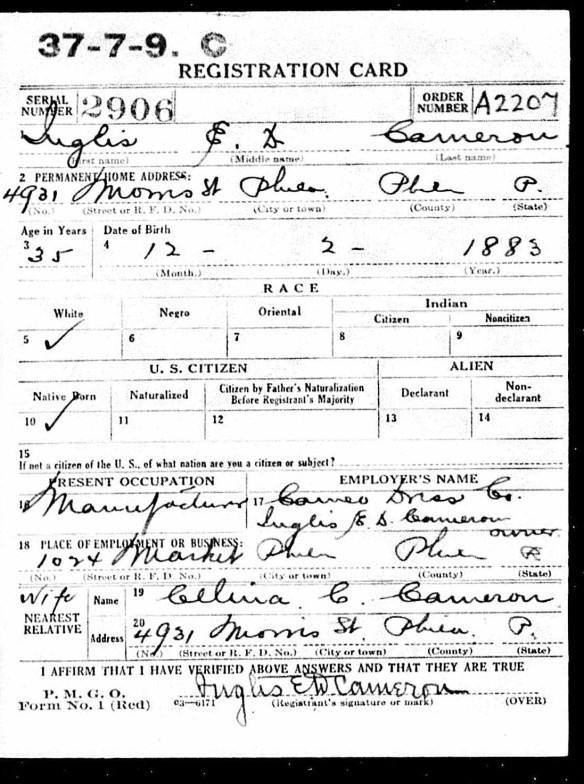
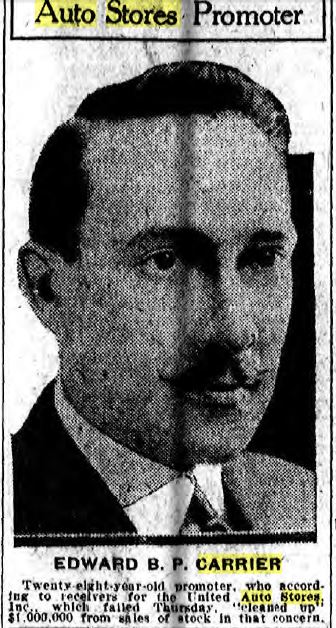

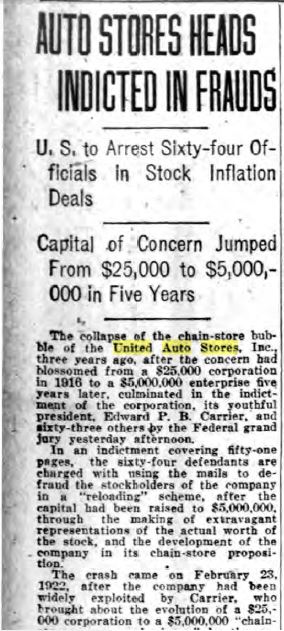
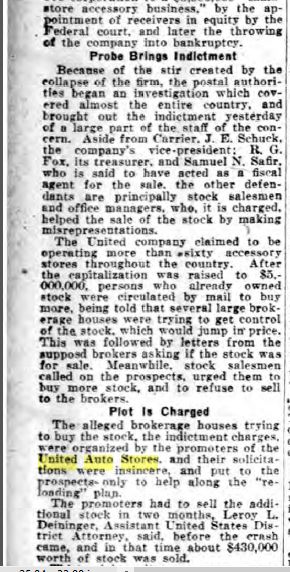





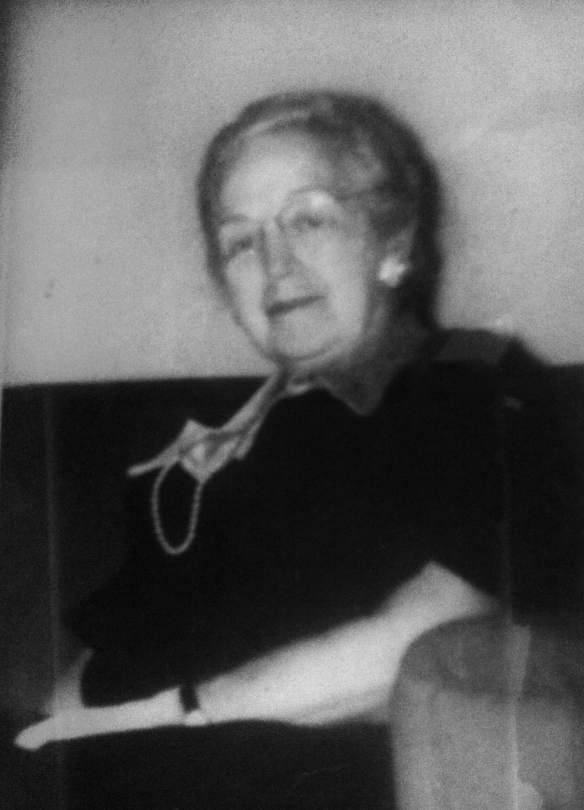
I think you are right. They changed their names to become hidden. Perhaps he did turn someone in. But not sure if the car accident in the end was related. Glad to have some answers.
LikeLike
Thanks for your thoughts. I also am not sure the accident was related, but it sure does seem suspicious to me. And were they hiding from the government, creditors, or criminals? So hard to know!
LikeLiked by 1 person
Imagine Amy, if you didn’t blog you may never have heard from Tracy. You’ve discovered so many pieces to the puzzle, I’m sure you’ll be able to find the missing ones which will make everything all fall into place.
LikeLiked by 1 person
I know—every once in a while I wonder whether it is worth it to write about those cousins who are somewhat distant. But if I hadn’t, I wouldn’t have heard from several of my cousins, including Tracy, Wolfgang, and others, all of whom have really helped me with my research. So I will keep on doing it!
LikeLiked by 1 person
You never know when a more distant relative will have the answer. Makes it hard to decide how far to go with collateral research.
LikeLiked by 1 person
That’s why I tend to keep going until I run out of sources to check!
LikeLiked by 1 person
Cousin Amy, I am Tracy’s and Ginger’s sister, Beckie. I’m the one that stumbled across your blog late one night and let my sister know. What a night that was, it was too late to call them. I read that portion about four times in all my excitement. I cannot thank you enough for the effort you have put into this and the incredible results. We have so many more answers now. I also appreciate the way you have treated the whole subject matter with respect. Thanks, Beckie Carnes Alden
LikeLike
Hi Beckie! I am so glad you commented. Now I am in touch with all three of you, and I am just delighted that you are all pleased with my work. It’s a true gift to me when a cousin find the blog and connects with me, so thank you so much for doing that and for telling Tracy and Ginger. I still hope that something new will pop up to fill in the gaps, but at least now we all know a bit more about who these people were, who their families were, and what their lives were like. Please stay in touch!
LikeLike
WHOA!!!!!!!!!! What a story!!! Look at what you’ve uncovered! or begun to uncover.
LikeLiked by 1 person
Any thoughts on what made them change their names and move? Always interested in what others see!
LikeLiked by 1 person
I have no idea, but it all seems shady or scary to me. And it might have a very benign explanation.
LikeLiked by 1 person
Yes, but you are hedging your bets!! What do you really think? 🙂
LikeLiked by 1 person
I don’t want to suggest anything bad about anyone in your family! And besides, who can know. They could almost all be pawns.
LikeLike
LOL! I always have a suspicious mind. 🙂 But I do think that IF he did anything wrong, he was probably a pawn in someone else’s scheme, as you suggested.
LikeLike
Oh, Amy, you have me intrigued. The amalgamated names you suggested make perfect sense to me, and my vote is for some early form of witness protection as the reason behind it all. I don’t know about the auto accident–no clear connection between the perp and the victims, but then again, if it were nefarious then precautions would have been taken to disguise the connection, right?
LikeLiked by 1 person
I think I need to do more to check into Homer Poole and see what else I can find. Thanks for your input! I do think they were hiding from the bad guys, not the law.
LikeLike
It seems to me you’ve done an admirable job! There certainly seems sufficient evidence to tie the two names together, and as to probable cause for the combination of both a geographical and an identity change, from this distance it would be difficult to be more specific. On balance I tend to agree that a ‘witness protection’ type solution fits better. Even in those less co-ordinated times the law would have been up to the task of tracing them, I think. So, what happened, I wonder, to Homer? Did he languish in a penitentiary for the rest of his years, or did he mysteriously drop out of sight? I’d kind of like the latter to apply, just for dramatic effect!
LikeLiked by 1 person
Glad you liked it—I know you like mysteries! As for Homer, I am still following up on it, but all I know so far is that he died in 1979, not in jail.
LikeLiked by 1 person
Pingback: Recommended Reads | Empty Branches on the Family Tree
Pingback: Tracy E. Carnes June 30, 1954-August 26, 2018 | Brotmanblog: A Family Journey